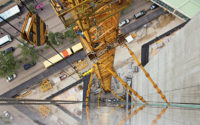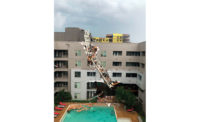When last month the U.S. Occupational Safety and Health Administration cited the de Moya Group over a fatal Florida highway crane accident last December, it accused the contractor of violating several standards, including a cardinal rule of crane safety: assuring that the ground on which a crane sits provides a stable base for its operation.
Failing to do so led to the death Dec. 5 of a 47-year-old carpenter, Joseph Bienaime, and a severe leg injury for another carpenter, claims OSHA . It proposes a $58,000 penalty that the contractor is contesting. A de Moya Group official could not be reached for comment, but in a statement issued at the time of the penalty July 5, the firm said its preliminary evaluation was "inconsistent with the citation."
The appeal is being made to the OSHA Review Commission—a separate, quasi-judicial entity that hears appeals in 23 states where the U.S. Labor Dept. enforces workplace safety. The commission does not hear appealed citations in 27 other states that enforce workplace safety on their own.
Appeals by contractors can take many months. ccording to the commission's fiscal 2022 annual report, its administrative law judges considered 1,546 cases, with nine out of 10 "simplified" cases decided within a year and 85% of more complex ones decided within 20 months.
Adding to the load is the Labor Dept. shift in focus from a high volume of safety violations to high-impact, complicated labor safety violation cases that take more time to consider, said the commission.
The OSHA commission case ruling on its website, other than the record of a citation and its brief summary, is often the most detailed public account of a workplace accident that does not require a Freedom of Information Act request to view.
Employee Hazard
In addition to the ground stability violation, OSHA charged de Moya Group with operating a crane with modified swing control, "exposing employees to the hazard of being struck by the crane or load" and failing to inspect the crane monthly.
“This tragedy never should have happened.” said OSHA Area Office Director Condell Eastmond. The total penalty covered four serious and one lesser violations.
In a de Moya Group statement issued at the time of the penalty announcement July 5, the firm said "the results of our preliminary evaluation are inconsistent with the citation issued by OSHA."
Some appeals to the OSHA commission involve fundamental disagreements about what occurred, what agency standards require of employers and who was at fault.
Appealing citations when possible to the OSHA Review Commission "is worth the effort," wrote two attorneys from the law firm Jackson Lewis on its website in May.One important purpose of the appeal, wrote Jackson Lewis attorneys Melanie L. Paul & Kristina H. Vaquera, is to challenge repeat, willful or failure-to-abate violations, which can be costly, to assure that they are not more properly classified as serious violations–a lower level of severity with lesser financial penalties. "Companies should utliize their resources to ensure any violations that are upheld are correct," the attorneys said.
Workers have a place in penalty appeals, too. Their testimony can play an important role, according to the Occupational Safety and Law Project, a worker safety advocacy group.
If the employer appeals to the commission, "a worker–or a group of workers–may formally participate in the case by “electing party status,” says the safety group, and they may play a role in commission enforcement actions, settlement negotiations and "'discovery actions to force employers to reveal hidden facts about the violations and the hearing on the citation."
The Chain Reaction
What happened in the Florida accident seemed pretty clear to rescue workers and OSHA investigators. Although on soft soil, the crane's unexpected movement the day of the accident, during a $153-million bridge expansion project on I-95 in Fort Lauderdale, set off a chain reaction.
The crew was preparing to drive a 90-ft-long, 17-ton concrete pile, which was on the crane line, and the two carpenters in a boom hoist were assisting as the crane operator attempted to place a hammer and leader on the pile.
It isn't clear if the pile itself was on the line or had been set or supported temporarily by another means.
When the crane sank forward, the leader–a steel frame in which the hammer drops on the pile head–struck the pile that in turn hit the boom hoist basket, sending it and the carpenters tumbling 30 ft to the pavement.
The text of this story was updated Aug. 8 to reflect that de Moya Group did not respond to a request for comment or update of the comment it issued a month earlier.





Post a comment to this article
Report Abusive Comment